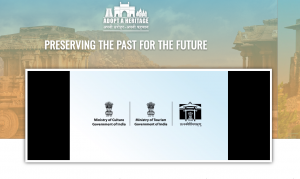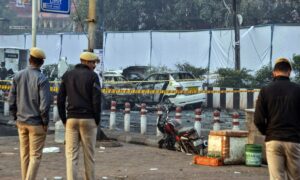
Source: Screengrab of the Adopt a Heritage: Apni Dharohar, Apni Pehchaan project
A controversy has erupted when the Modi Government decided that Red Fort will be managed by a corporate under the “Adopt a Heritage: Apni Dharohar, Apni Pehchaan” project. The opposition parties and a huge number of people started criticising the government step to handover the historic monument to the private player. Without consuming much time, the Tourism Ministry released a press communiqué to clarify. As the press release stated, ‘Adopt a Heritage’ scheme is for development, maintenance and operation of Tourism amenities in monuments. The project envisages limited ‘access’ to non-core areas and ‘no handing over of monuments’ are involved. In this backdrop, there is a need to understand the Adopt a Heritage project, what’s Modus operandi, how many monuments have been identified under the project, who can associate with it and what is vision bidding and why the government is keen to introduce such projects?
According to the Project Guidelines, ASI as on date protects 3,686 ancient monuments and archaeological sites including 36 world heritage sites. In the project document, it is stated that we need to provide basic and advanced amenities, illumination, night viewing facilities with safety and security to tourists, adaptive use of heritage site within permissible guidelines of ASI, and an overall enhanced tourist experience that will result in an increase of domestic and foreign tourist footfall. As of now, total 93 tourist places have identified, 403 registrations for Monument Mitras have completed and 4 tourist places are adopted under the project Adopt a Heritage according to the given information.
Vision Statement:
Ministry of Tourism in close collaboration with Ministry of Culture and Archaeological Survey of India (ASI) envisaged developing the heritage sites, monuments and any other tourist sites by making them tourist-friendly to enhance the tourism potential and their cultural importance, in a planned and phased manner.
Objectives:
Develop basic tourism infrastructure in and around heritage monuments and any other tourist sites
Inclusive tourist experience for heritage site/monument or tourist site
Promote cultural and heritage value of the country to generate livelihoods of local communities of respective heritage site/monument/ tourist site
Enhance the tourist attractiveness in a sustainable manner by developing world-class infrastructure at heritage site/monument or tourist site
Create employment through active involvement of local communities
Harness tourism potential for its multiplier effects in employment generation and economic development
Develop sustainable tourism infrastructure and ensuring proper Operations and Maintenance therein
List of active projects under adoption under Phase I:
| S.N. | Name of Historical Site | City & State |
| 1 | Hampi | Karnataka (Green) |
| 2 | Leh Palace | Jammu & Kashmir (Blue) |
| 3 | Qutub Minar | Delhi (Green) |
| 4 | Ajanta Caves | Maharashtra (Blue) |
| 5 | Purana Qila | New Delhi (Blue) |
| 6 | Safdarjung Tomb | New Delhi (Blue) |
| 7 | Agrasen Ki Baoli | New Delhi (Other) |
| 8 | Gangotri Temple Area & Trail to Gaumukh | Uttarakhand (Others) |
| 9 | Mt. Stok Kangri | (Ladhakh, J&K) (Others) |
| 10 | Sun Temple | Konark, Odisha (Green) |
| 11 | Ratnagiri Monuments | Odisha (Orange) |
| 12 | Raja Rani Temple | Bhubaneswar, Odisha (Others) |
| 13 | Jantar Mantar | New Delhi (Blue) |
| 14 | Mattancherry Palace Museum | Kochi, Kerala (Green) |
Source: http://www.adoptaheritage.in/pdf/list_of_adopted_sites_2017.pdf
List of active projects under adoption under Phase II:
| S.N. | Name of Historical Site | City & State |
| 1 | Taj Mahal | Agra (Corridor) (Green) |
| 2 | Itimad-Ud-Daula | Agra (Orange) |
| 3 | Red Fort | Agra (Green) |
| 4 | Golconda Fort | Hyderabad (Green) |
| 5 | Rock Cut Hindu Temple | Undavalli, Guntur (Blue) |
| 6 | Ramappa Temple | Palampet, Telangana (Others) |
| 7 | Kotla Feroz Shah | Delhi (Orange) |
| 8 | Khajuraho | Madhya Pradesh(Green) |
| 9 | Elephanta Caves | Maharashtra (Green) |
| 10 | Jaisalmer Fort | Rajasthan (Others) |
| 11 | Kolaba Fort | Alibaugh (Orange) |
| 12 | Old Goa Churches | Goa (Blue) |
| 13 | Aguada Jail | Goa (Others) |
| 14 | Sassoon Docks | Mumbai (Others) |
| 15 | Char Minar | Hyderabad (Green) |
| 16 | Udayagiri & Khandagiri sites | Bhubaneshwar (Blue) |
| 17 | Gandikota Fort | Kadapa, Andhra Pradesh (Others) |
| 18 | Red Fort | Delhi (Green) |
| 19 | Gol Gumbar | Bijapur (Green) |
| 20 | Adham Khan fort | Delhi (Others) |
| 21 | BioDiversity Park, Vasant Kunj | Delhi (Others) |
| 22 | Bhuli Bhatiyariin | Delhi (Others) |
Source: http://www.adoptaheritage.in/pdf/list_of_adopted_sites_2017.pdf
List of active projects under adoption under Phase III:
| S.N. | Name of Historical Site | City & State |
| 1 | Nalanda | Bihar (Green) |
| 2 | Mahabodhi | Bihar (Others) |
| 3 | Sanchi Stupa | Madhya Pradesh (Orange) |
| 4 | Nahargarh Fort | Jaipur (Others) |
| 5 | Surajkund | Faridabad (Others) |
| 6 | Khan-I-Kahan | Delhi (Others) |
| 7 | Tipu Palace | Bengaluru (Orange) |
| 8 | Kumbhalgarh Fort | Kumbhalgarh (Others) |
| 9 | Basilica Bom Jesus | Goa (Others) |
| 10 | Amer fort | Jaipur (Others) |
| 11 | Qutub Shahi Tombs | Golconda, Hyderabad (Others) |
| 12 | Humayun Tomb | Delhi |
| 13 | Kaziranga National Park | Assam (Others) |
| 14 | Sibsagar Monuments | Assam (Orange) |
| 15 | Moth ki Masjid | Delhi (Others) |
| 16 | Tomb Lado Sarai | DDA Park, Delhi(Others) |
| 17 | Mosque, Lado Sarai Village | Delhi (Others) |
| 18 | Tomb, Lado Sarai Village | Delhi(Others) |
| 19 | Mahabalipuram | Tamil Nadu (Orange) |
| 20 | Ellora | Aurangabad, Maharashtra (Green) |
Source: http://www.adoptaheritage.in/pdf/list_of_adopted_sites_2017.pdf
HOW TO BE A MONUMENT MITRA:
As the Project Guidelines document stated, “The heritage site/monument or any other tourist site are selected on the basis of tourist footfall and visibility. The project entails to handover heritage sites and monuments for adoption to the private and public sector companies and individuals (who would be known as “Monument Mitras”) for providing basic amenities and complete operation and maintenance (O&M) initially for the 5 years subject to review at any time, regular monitoring and feedback mechanism from all the stakeholders including tourists.”

Source: Adopt a Heritage: Apni Dharohar, Apni Pehchaan
The potential Monument Mitra selects historical sites or tourist places and submits the Expression of Interest (EOI). The competent authority shortlists the EOI and it’ll be followed by the vision bidding and evaluation process. The competent authority selects the Monument Mitra based on the stated parameters. After this stage, Ministry of Tourism, Ministry of Culture, Archaeological Survey of India (ASI) and representative of the Monument Mitra (or corporate).
As the government document underlined, “In the indicative list of sites, the heritage sites/monuments are categorized as green, blue and orange on the basis of tourist footfall and visibility. The requirement of basic amenities would be calculated based on the asset wise service level benchmarking. The Monument Mitras are supposed to present a vision for the development of all necessary/mandatory basic amenities and advanced amenities for each of the heritage site that they take up as a package (combination of Green-Blue-Orange) enlisted and any other heritage sites, monuments and tourist site. The most competitive and innovative vision would be considered as the successful bidding entity.”
According to the Project Guidelines document, “The interested parties selecting more numbers of monuments from orange and blue category shall be given higher weightage. Bids would be primarily evaluated on the basis of the capacity of bidders, their success stories in delivering similar projects, value addition to the selected heritage sites. This concept of innovative bidding is defined as ‘Vision Bidding’.”
The Government of India constituted three committees such Oversight and Vision Committee, Implementation Committee and Monument Committee.
The basic amenities are categorized as below:
• Public Conveniences
• Ease of Access
• Aesthetics and cleanliness of the site
As the Government is recognizing the project as Incredible India 2.0 which listed a huge number of well-known historical sites from states like Delhi, Orissa, Tamil Nadu, Bihar, and Maharashtra. It is evident that Delhi is dominating the pie. Historical sites from the North East are largely ignored. The government advocates to engage the Project Management Unit (PMU) of course it’ll be another private entity. Almost all sites are leading historical sites in India where basic amenities are better than the rest. If the government is serious about encouraging the tourism, they must engage the corporate and private players in the remote historical sites. Engaging the corporate as Monument Mitras in the well-known site is an ill-conceived idea and inspired by the neo-liberal agenda of the government. It shows that how the government is failed to maintain, restore and manage the historical sites and how all governments ignored a huge number of sites of the national importance? One can say that managing and maintaining the historical sites in India has become financially unviable and the authorities are trying to lag the gap. An institution like ASI has inadequate resources to restore and to deal with India’s cultural past. Allocation of the funds for such entities must be examined.


















